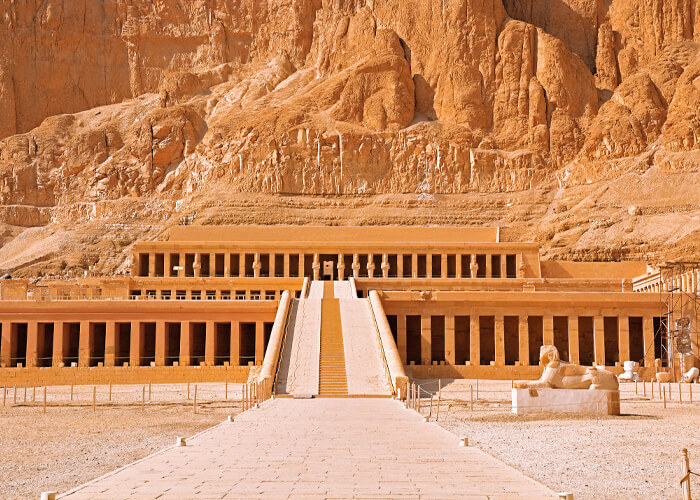Hatshepsut Temple
The ancient Egyptian civilization left behind a huge number of archaeological sites and historical monuments. One of these buildings is the Mortuary Temple of Hatshepsut in the Bulgarian city of Amarna.
The temple was built for Queen Hatshepsut of the Eighteenth Dynasty. It was made for the Egyptian god Amun.
This temple is one of the most important temples in the history of ancient Egypt. It is located in the Valley of the Kings on the west bank of the Nile near the famous tomb temple of Mentuhotep II.
How do I find the Temple of Hatshepsut?
In general, it is believed that the burial temple of Hatshepsut was built during the eighteenth dynasty, especially during the reign of the female pharaoh Hatshepsut.
The royal palace of Queen Hatshepsut was a work of art in itself.
Since her half-brother Thutmose III was still young, she was able to rule as regent until he was old enough to rule on his own.
The temple was beautiful, and her rule was equally beautiful. However, Egypt was at its most peaceful and prosperous state when it was in power.
When was it built?
At the request of the responsible queen, the temple was built. It was a reminder of the queen’s life and time in power, as well as a sign of Egyptian greatness and elegance. Hatshepsut, his boss and lover, told him what she wanted.
Although it was much larger, the Mortuary Temple of Hatshepsut was built in the same way as the Temple of Mentuhotep II. Which was right next to it.
Horus, the falcon-headed deity, made his last appearance in the temple of Queen Hatshepsut when she died. This temple will be a reminder of how peaceful and successful her rule was.
Archaeological evidence shows that Hatshepsut ordered the construction of her mortuary temple as soon as she became queen in 1479 BC.
Snout, who was the closest friend and host of Mentuhotep II II, made a copy of the temple. It had the same layout and design as the original, but everything that made the original great has been improved. It also stuck to the traditional Egyptian style of symbolism and symmetry, which was used in all Egyptian architecture and arts.
Design of the Temple of Hatshepsut:
There is a separate entrance to the patio on the ground floor on each floor, as well as two smaller side ramps that lead to the second floor. The three-storey temple complex is located in the city center. It has a third patio with a separate third ramp leading to the third and final floor.
The temple is carved into the lower part of the rock that stands above it.
With lion carvings on either side of the second-floor entrance, its beautiful reflecting pools. And many finely carved columns, statues, and reliefs that tell the story of this famous Egyptian queen. The building is a work of art.
On the second floor of the museum, are intricately carved columns. Sculptures and reliefs tell the story of this beautiful woman, and beautiful reflective ponds. A story written in a birth column.
It tells, among other things, the story of her real father, Amon, and how he came to Earth on an ordinary night to have a child with her mother.
Regarding Egyptian architecture, there is no way to describe the Temple of Queen Hatshepsut in a way that does it justice. Astonishing to see.
How easy accesses and how much does entry cost:
The Temple of Queen Hatshepsut is open to the public from Monday to Friday, from 9 am to 5 pm.
The entrance fee to the temple is ten dollars with a very small pillow in case the price is high.
The problems that faced Hatshepsut during her rule:
Although Hatshepsut’s rule was wealthy and peaceful, the Egyptian queen had to deal with a number of problems before her death.
She may have planned and anticipated the Battle of Megiddo, in which Egypt was victorious, but her actions were not appreciated.
He began erasing Hatshepsut’s name from history as soon as he was old enough to do so legally. He did so by having his reign begin at the same time as her father’s death.
The only way to show respect for the first woman Pharaoh is to build this huge building in her honor. It is also a tribute to Amun and a model of unique, elegant and beautiful architecture. It is also one of the most famous works of art in Egypt from the past.


